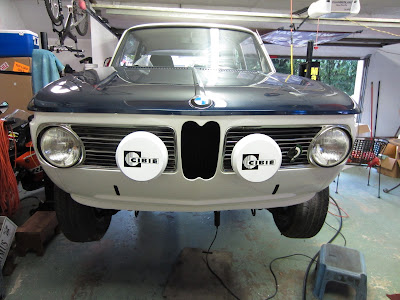I've been motoring along, working in the engine compartment, bolting this bit here, that bit there when I ran into a small detour, typical when restoring a 40 year old vehicle. I had bolted in the upgraded starter and attached the wiring harness. Splitting off the harness was the plug for the alternator at the front of the motor. I couldn't directly see the 3 prongs it plugged into, but I could see the hole surrounding them. I started pushing the plug but instead of that nice smooth tension that tells you it's going well, it started feeling "mushy". I immediately stopped and pulled the plug out. This calls for some up close inspection.
 |
| Naked Alternator |
After many years, pulling and inserting plugs, removing and tightening nuts and bolts, there's a very specific feel to the process. And I've learned that any deviation from that feel requires a full stop and lookie. Otherwise, pain, time and money are forecast for the future.
Practicing my yoga skills learned on the internet, I managed to twist my head, droplight and reading glasses into a position where an oblique view showed me the 3 prongs, which should have been parallel to each other, weren't.
Inserting my finger, two of the prongs wiggled. This is not good. The only thing to do is pull the alternator and inspect it on my work bench. A careful inspection showed me the connector wasn't attached anymore and wasn't going to be fixed from the outside. It was time to dive into the mysteries of Alternator repair. This will be a new journey for me.
 |
| Closer view of the misbehaving connector |
2 days later, after numerous dousings of PB Blaster, heating with a propane torch, a BFH and vice grips, the secrets of the generator were revealed.
 |
| The culprit - the brushes and connector |
 |
| In the Repair Booth - calling Dr SuperGlue ... |
 |
| Good for another 40 years |
 |
| Project deviation finished, back on track |
Since there are still many things left to do, I didn't just sit around and watch the PB Blaster work. Next up was the brake booster and master cylinder. This should be reasonably straightforward job with one known pain point, the installation of the "bitch clip".
As it turns out the installation of the infamous clip went relatively smoothly. It connects the brake pedal lever from the cockpit to the actuator rod from the back of the brake booster. The space to work in is very limited and the sequence of actions require force vectors from different directions. Other than dropping the clip a couple of times and having to fish it out with a magnetic stick, it was done in 5 minutes.
What didn't go smoothly was connecting the brake lines to the master cylinder. The first two went easily, lulling me into dropping my guard. And then I heard that laughter again and this time, the TV wasn't on.
 |
| Brake booster - large round device bottom right, master cylinder is the long cylinder in the middle. Brake lines attach to the sides and bottom. |
Like I said, the first two lines, in like Flint, but the 3rd... This was coming up from bottom. See the issue here is, the fitting isn't forgiving or sloppy. Some bolts and holes are loose and you can kinda wiggle to get started. The bolt will catch and automatically straighten up into alignment. This is the "feel" I was talking about earlier with the alternator connector. With the brake lines, the fitting needs to be perfectly perpendicular on all sides to get started and get threaded. With everything bolted and rigid this is an impossible task. So you loosen everything, twist and bend the lines. Since you can't see the line coming into the bottom you fiddle and wiggle, and fiddle some more. You think you get it started, turning one small thread at a time and .... it doesn't catch, it pops out. Brake line #3 took 60 minutes of work over 2 nights. I finally ended upside down in my engine compartment so I can eyeball the alignments. 10-15 minutes for each of the other lines, but it was finally done. You just never know where you're going find problems.
With that behind me, it was time for some fun, brainless activity. I fitted my grills, and the vintage Cibie driving lights. They'll have to come back off when I do the final adjustment of the hood, but they look pretty good.
 |
| With H4's and the Cibie's, I should be throwing down some serious light power |
Attached the Euro spec turn signals Maggie got me for my birthday to replace the hideous US spec frog eyes.
And attached my Nurburgring grill badge. And since I have driven the Ring, 3 days in a BMW, I'm not a poseur and have been granted the right by the German government.
The only major mechanical task is hooking up the clutch bits. Then I'll be ready to try to start it. I'm sure I'll have plenty of issues, gremlins, leaks etc to chase down after then. But I'm getting close.



.jpg)


No comments:
Post a Comment